1. Introduction
 There
is not much that we can say about Asus that hasn't already been said. Asus
has been in the industry for a long time, manufacturing quality products.
In 2003, Asus sold 5,000,000 motherboards which means one out of every 5
desktop computers was built using an Asus motherboard. In the VGA arena,
Asus is known for two things: its quality and its slightly pricier products.
There
is not much that we can say about Asus that hasn't already been said. Asus
has been in the industry for a long time, manufacturing quality products.
In 2003, Asus sold 5,000,000 motherboards which means one out of every 5
desktop computers was built using an Asus motherboard. In the VGA arena,
Asus is known for two things: its quality and its slightly pricier products.

It's time to put the Asus N6600GT AGP on our testbed. You
can tell an AGP 6600GT from the PCI-Express version from the distinguishing
features: the 45-degrees rotated GPU core and the extra heatsink below the
GPU.
Underneath
the
heatsink, you'll find NVidia's High Speed Interconnect (HSI) bridge, responsible
for translating between the native PCI-Express NV43 chipset
and the AGP.
- Packaging/Bundle
The N6600GT AGP package is identical to the PCI-E
version "Extreme 6600GT" from Asus. What stands out
is the TOP sticker found on the upper right on the package. TOP
is a recursive name standing for Top Overclocking Performance
and indicates the already increased clock speeds of the N6600GT, plus the
ability
to further overclock the memory.
 |
| Asus N6600GT AGP |
Inside the package, you'll find a set of CD-ROMs with the
following software:
Software Bundle:
- Joint Operations : Typhoon rising (full version)
- Xpand Rally (full version)
- Medi@Show SE 2.0
- Asus CD manual
- Asus VGA driver CD
Notice something missing? There's no Asus CD Suite included
with the Asus N6600GT. The package is still designed with a round-shaped
place holder for CD Suite, but that space is now empty. At
first we thought that there had been a mistake, but apparently Asus has decided
to
exclude it from the AGP version of its N6600GT, perhaps to cut down on
the overall cost of the card.
Apart from the software accompanying the Asus N6600GT, a DVI-to-VGA
adaptor and an S-video cable are also included inside the box.
Warranty:
All Asus graphics cards are covered by a 3-year warranty.

2. Features-TurboCache
| Main Features |
| GPU |
Nvidia 6600GT - NV43 rev.A2 |
| Memory Brand/Model |
Samsung K4J55323QF-GC16 (1.6ns) |
| Memory Type |
128 MB 128-bit DDR |
| Engine Clock Speed |
520MHz |
| Memory Clock Speed |
550MHz (1.1GHz effective) |
| Memory Bandwidth |
17.7 GB/sec |
| Pixel Pipelines |
8 |
| Vertex engines |
3 |
| Fill rate |
4.16 Giga pixels/sec |
| DX Support |
9.0 |
| OpenGL Support |
1.5 |
| Output |
VGA / DVI-I / D-Sub |
| Bus |
AGP 8x/4x |
| Processing technology |
0.11 micron |
As we mentioned earlier, the N6600GT is clocked higher than other brand 6600GTs.
Its clocks are set at 520MHz for the core and 550MHz for the memory,
thus reaching an effective speed of 1.1GHz which is the same as the 6800 Ultra's
clock speed.
The Nvidia 6600GT AGP reference model used 2.0 ns memory as in the case
of the MSI 6600GT AGP card which we have previously reviewed. Asus however
decided that they wanted to stand out from the crowd and have used memory modules
that
support
higher access speeds (1.6ns), hence increasing the maximum theoretical
memory bandwidth.
| |
Asus N6600GT |
Nvidia 6600GT |
| Engine Clock Speed |
520MHz |
500MHz |
| Memory Clock Speed |
550MHz (1.1GHz effective) |
450MHz (0.9GHz effective) |
| Memory Bandwidth |
17.7 GB/sec |
14.5GB/sec |
| Fill rate |
4.16 Giga pixels/sec |
4.0 Giga pixels/sec |
Features
NVIDIA CineFX 3.0 engine
Full support for Microsoft DirectX9.0 Shader model 3.0 enables stunning and complex special effects
NVIDIA UltraShadow II technology
Enhances the performance of bleeding-edge games
NVIDIA Intellisample 3.0 technology
The industry's fastest antialiasing delivers ultra-realistic visuals, with no
jagged edges, at lightning-fast speed
NVIDIA nView multi-display technology
Provides the ultimate in viewing flexibility and control for multiple monitors
Digital Vibrance Control 3.0 Technology
Allows the user to adjust color controls digitally to compensate for the lighting conditions of their workspace, in order to achieve accurate, bright colors in all conditions.
On-Chip Video Processor
Delivers unmatched video performance, features, and quality.
Microsoft DirectX 9 and OpenGL 1.5 support
AGP 8X support
3. A closer look
The Asus N6600GT is fabricated on a blue PCB following
the reference design from NVidia. The GPU and its HSF have been rotated
so that an extra
chip can
fit on the board.
 |
| The front side of the card.(click for hi-res). |
That chip is the HSI (short for High Speed Interconnect) and its
purpose is to provide AGP support for the PCI-Express-native GPU used on
the N6600GT.
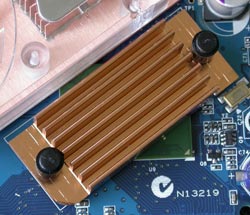 |
| The HSI chipset and its heatsink |
 |
| The front side of the card.(click for hi-res). |
As you can see, all the memory parts are located on the front
side of the 6600GT, leaving the back view empty. Even though the GPU fansink
covers most of them, it doesn't actually come into contact with them
since they don't need cooling.
 |
| Enlarged picture of the NV44 |
Removing the heatsink reveals the NV43 core on the N6600GT which is
shown in the picture below.
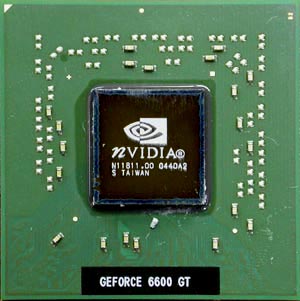 |
| Enlarged picture of the NV44 |
As with all AGP 6600GTs, the N6600GT also needs extra power for its circuits
to operate correctly. A power socket exists near the right edge of the card
where you have to plug in a molex power connector from your power supply.
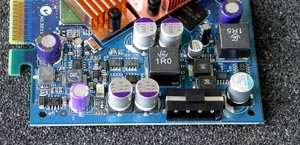 |
| The power socket for the N6600GT |
The Asus N6600GT can output 3 kinds of signals. One for TV-out, one DVI for TFT monitors and one for the standard CRT output.
 |
| S-Video, DVI and the standard VGA output |
4. Test System
Processor: AMD 4000+ S939
Cooler: Stock AMD Heatsink-Fan
Case: Antec 1080AMG
Motherboard: Asus A8V Deluxe
Memory: 2x512MB OCZ PC-4200 Memory
Hard Disk Drive: WD800JD 80GB 7200RPM
DVD-RW: LiteOn LTR-52246S
PowerSupply: Levicom 500Watt
Microsoft WindowsXP Pro SP2
DirectX v9.0c

Benchmarking Software
3DMark05,03,01
Codecreatures Benchmark Pro
AquaMark3 v3.0
ATiTool 0.0.23
Farcry v1.3
CounterStrike Source
Doom 3
Thief 3
Ground Control II
5. 3DMark05
 With 3DMark05, Futuremark continues the tradition in its benchmarking software by providing a state-of-the-art Microsoft ® DirectX ® 9 3D performance benchmark.
With 3DMark05, Futuremark continues the tradition in its benchmarking software by providing a state-of-the-art Microsoft ® DirectX ® 9 3D performance benchmark.
3DMark05 is an all new 3DMark version taking the most out of Microsoft's
DirectX 9. The previous version 3DMark03, did a nice introduction into
this level
of technology. However, 3DMark03 used DirectX 9 specific features in a limited
manner, because fully supporting  hardware
was rare at the time of its launch. In contrast, 3DMark05 requires DirectX
9 hardware with full support for at least Shader Model 2, and takes shader
usage to never before seen levels.
hardware
was rare at the time of its launch. In contrast, 3DMark05 requires DirectX
9 hardware with full support for at least Shader Model 2, and takes shader
usage to never before seen levels.
Just like its predecessors, 3DMark05's point system is set so that at the
moment of release, the high-end VGA cards available in stores can only score
around 5000 3DMarks, whereas the worst card that meets the program's requirements
yields a score of 1000.
Game Test 1 -Return to Proxycon
Being the sequel to the "Battle of Proxycon"
from 3DMark03, in "Return to Proxycon" we're once again set in space
and the battle continues as space pirates invade a cargo ship in order to
take control of its valuable cargo.

This test, tries to simulate a future first-person shooter game with all the high details that entails. The dynamic shadows, high-detailed environment and advanced lighting techniques ensure that under normal circumstances, no recent card can run it with decent frame rates.
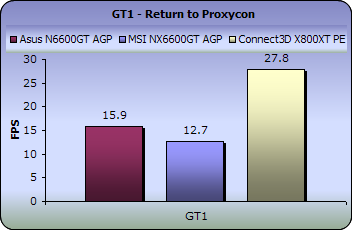
3DMark05 starts off with the Asus N6600GT taking a serious
lead over the MSI 6600GT at around 16fps. The X800XT from Connect3D however,
shows the way a high-end card can render this game test.
Game Test 2 - Firefly Forest
A forest gets filled with magic fireflies in the night. The moon is nearly full, illuminating the forest with a bluish faint light. The magic fireflies have flickering bright green lights that playfully move around the forest.
This scene is a nice example of a smaller scale outdoor scene with rich vegetation. Immediate visibility is not so far, and there is a skybox surrounding the whole scene.

A large number of trees with their branches swinging separately, and dense vegetation being dynamically distributed according to the camera movements, make this test the most demanding of the three.
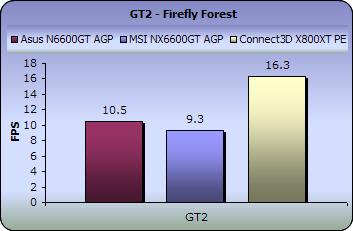
Firefly forest as always is very lighting-intense, creating
a drop in performance with all graphics cards. The two 6600GT models performed
similarly in this test but with the Asus card doing a little better.
Game Test 3 - Canyon Flight
A Jules Verne type airship flies through a canyon guarded
by a dangerous sea monster. The airmen defend their ship using heavy cannons,
but these seem to have no effect on the huge sea monster.
Finally the crew manages a narrow escape using the "last resort" afterburners
of the airship.
This scene is fairly complex with large areas of
water reflecting the high canyon walls. The water actually is one of the key points of interest in this scene.
The water not only does realistic looking reflections and refractions, it has a depth fog, making the sea
monster swimming under the airship actually look deep down in the water. The air in this scene also uses
a volumetric fog, making distant cliffs of the canyon really look far away.

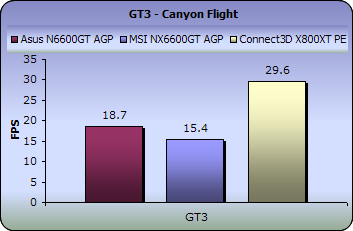
In "Canyon Flight", the difference once again increases
as this test is much lighter than the previous two. The X800XT PE almost
reached 30fps with the 6600GTs output reaching just over half
that.
Final Score
3DMarks on 3DMark05 are now calculated by the following formula:
(Game Test 1 * Game Test 2 * Game Test 3)^0.33 * 250
This is basically the geometric mean of the total frames
in each game multiplied by 250. This means that all game tests are now equal.
Let's see our results for the Asus N6600GT:
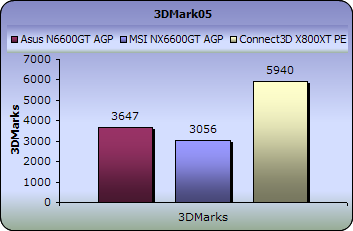
The final 3DMark05 reveals an impressive power increase
coming from the Asus card. Its higher clock speeds seem to bring a great
boost in
performance
leaving the stock-clocked MSI NX6600GT 600 3DMarks behind.
6. 3DMark 2003
 3D Mark is a widely used and accepted benchmark that stresses the DirectX performance of a VGA card. A very strong point of 3DMark is that it's VGA card measuring is does not require any CPU power. So the resulting fps are a good reference a VGA card's rendering performance. For testing the performance of each card we used the 4 game benchmarks 3DMark has.
3D Mark is a widely used and accepted benchmark that stresses the DirectX performance of a VGA card. A very strong point of 3DMark is that it's VGA card measuring is does not require any CPU power. So the resulting fps are a good reference a VGA card's rendering performance. For testing the performance of each card we used the 4 game benchmarks 3DMark has.
3Dmark03 also includes sound and CPU tests as well as some other feature tests.
- Game Test 1 - Wings of Fury (DX7)

This test is a combat flight simulator written for older
hardware (DirectX 7). Particles are used a lot in this test - smoke and vapor
trails, flak and gunfire, and explosions are produced using point sprites
and quads.
- Game Test 2 - Battle of Proxycon (DX8)

This test is a simulation of first person shooter game types. 1.1 and 1.4 Vertex shaders are widely used since all character models are skinned using vertex shaders.This makes this test a good vertex shader comparison for VGA cards.
- Game Test 3 - Trolls' Lair (DX8)

This test should be the favorite of all RPG lovers. It is a cut scene of a female warrior facing two malicious trolls. Again the same vertex and pixel processing is used as in game test 2.
This test also uses post-processing effects, such as Depth of Field and Bloom effects which are widely used in today's game cut scene sequences.
- Game Test 4 - Mother Nature (DX9)

Mother nature represents the level of effects and realism that are possible using 2.0 vertex and pixel shaders, plus some other features that DirectX 9 offers.
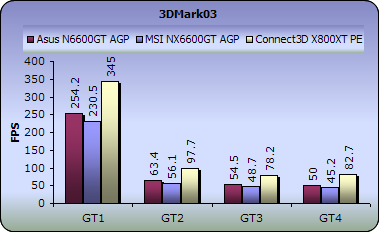
In the DirectX 7 based GT1, the Asus N6600GT produced an over-the-top
254fps, 24 fps more than its relative from MSI. Moving on to the last three
games, surprisingly the difference is still there ranging from 5 to 7fps. The
X800XT is once again incomparable and showing off its power against the mid-end
6600GTs.
- 3DMark Official score
If you test your machine with 3DMark, you can post the results
at 3DMark's online result browser. For more information visit futuremark.com.
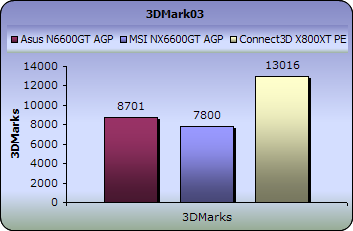
It is really amazing what a new set of memory and different clock
speeds can bring in performance. The N6600GT was able to outperform the
6600GT from MSI by a total of 900 3DMarks!
7. Codecreatures
 CodeCreatures is a synthetic 3D benchmark that is a good reference for VGA performance comparison. This is a high-end 3D benchmark that also requires DirectX 8 hardware, making a good tool for measuring the potential of DirectX 8 game performance.
CodeCreatures is a synthetic 3D benchmark that is a good reference for VGA performance comparison. This is a high-end 3D benchmark that also requires DirectX 8 hardware, making a good tool for measuring the potential of DirectX 8 game performance.
The Codecreatures benchmark is written with Microsoft's DirectX  8.1 API and incorporates the use of Vertex and PixelShaders popular on next generation 3D accelerators.
8.1 API and incorporates the use of Vertex and PixelShaders popular on next generation 3D accelerators.
The benchmark plays a photo-realistic nature scene and calculates the performance of the graphics adapter by measuring the fps that it can display at 1024x768, 1280x1024 and 1600x1200 resolutions.
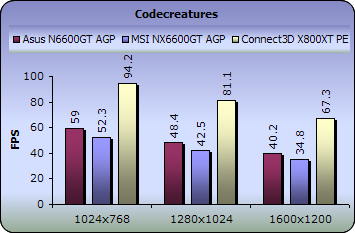
-Codecreatures number
The codecreatures number is the resulting score of the total benchmarking process and is basically the geometric mean of the three framerates multiplied by 100.
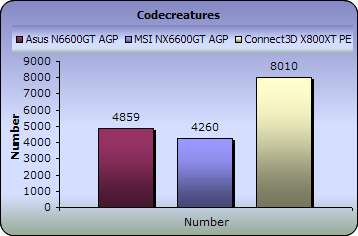
The MSI NX6600GT was able to run codecreatures with satisfactory
framerates, reaching 34fps at 1600x1200. However, the N6600GT once again
stands out with
better performance without falling below 40fps. The results position
the Asus
N6600GT as the definite leader with a 600 higher codecreatures score.
8. Aquamark3 / 3DMark 2001
 Since the majority of today's applications and games are compatible with DirectX 9, the need of benchmark applications that use DX 9 has been brought up. The benchmark uses the 3D engine (Krass engine) of the Aquanox game.
Since the majority of today's applications and games are compatible with DirectX 9, the need of benchmark applications that use DX 9 has been brought up. The benchmark uses the 3D engine (Krass engine) of the Aquanox game.
Aquamark Triscore
The Aquamark Triscore comprises 3 values: the overall system performance, the performance of the graphics system and the CPU performance. Keep in mind that this is not the total result of the tests, but the result of the whole benchmark process including all 9 chapters.
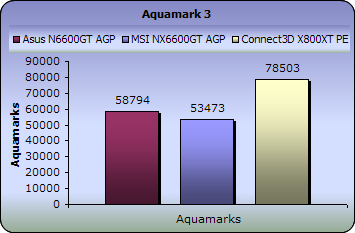
3DMark 2001
3DMark 2001 is the predecessor to 3DMark03. It's mainly a directx8.1 benchmark and the score depends a lot on the CPU power of your computer. However for reference use only we decided it'd be best to just leave it in our benchmark list so you can compare the next generation cards with the possibly outdated you have at home.
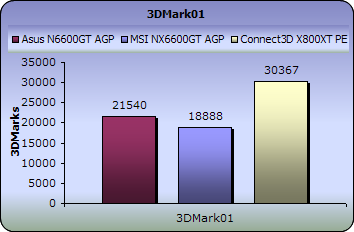
9. Half life 2
Half life 2 is no doubt the most anticipated pc game of all times. Gamers keeping the excellence of Half Life 1 in their mind as well as the remarkable E3 demo preview, have been anxiously waiting for the much delayed release of HL2.
 Regarding the storyline, the player again picks up the crowbar of research scientist Gordon Freeman, who finds himself on an alien-infested Earth being picked to the bone, its resources depleted, its populace dwindling. Freeman is thrust into the unenviable role of rescuing the world from the wrong he unleashed back at Black Mesa. And a lot of people he cares about are counting on him.
Regarding the storyline, the player again picks up the crowbar of research scientist Gordon Freeman, who finds himself on an alien-infested Earth being picked to the bone, its resources depleted, its populace dwindling. Freeman is thrust into the unenviable role of rescuing the world from the wrong he unleashed back at Black Mesa. And a lot of people he cares about are counting on him.
Characters - Advanced facial animation system delivers the most sophisticated in-game characters ever seen. With 40 distinct facial "muscles," human characters convey the full array of human emotion, and respond to the player with fluidity and intelligence.
 Physics - From pebbles to water to 2-ton trucks respond as expected, as they obey the laws of mass, friction, gravity, and buoyancy.
Physics - From pebbles to water to 2-ton trucks respond as expected, as they obey the laws of mass, friction, gravity, and buoyancy.
Graphics - Source's shader-based renderer, like the one
used at Pixar to create movies such as Toy Story® and Monster's, Inc.®,
creates the most beautiful and realistic environments ever seen in a video
game.
 AI - Neither friends nor enemies charge blindly into the fray. They can assess threats, navigate tricky terrain, and fashion weapons from whatever is at hand.
AI - Neither friends nor enemies charge blindly into the fray. They can assess threats, navigate tricky terrain, and fashion weapons from whatever is at hand.
To measure performance we used the Video Stress Test(VST) that is available in the CounterStrike:Source beta available through Steam. We set all the details to the highest level and each time changed the resolution from 800x600 up to 1600x1200.

At 800x600, the X800XT was severely limited by the CPU
so as we can see, the N6600GT from Asus manages to achieve
similar performance. However, the lower performance of the MSI NX6600GT at
800x600 is not at
all due to
CPU
limitations. As we increase the resolution, the difference between it and
the Asus N6600GT slowly diminishes but even at 1600x1200 there's still
a noticeable 22 fps gap.
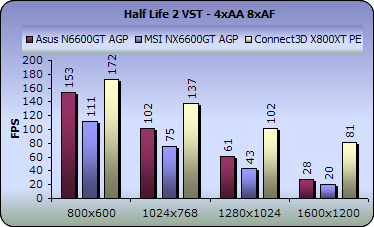
When we enable 4x Anti-Aliasing and 8x Anisotropic Filtering,
with the first two resolutions all of the cards offer excellent performance.
However, when we reach 1280x1024, the 6600GT from MSI can no longer keep
up with the other two cards and is clearly outperformed by the Asus
N6600GT. Finally,
at 1600x1200, the highest resolution, only the performance monster X800XT
PE is left standing, able to deliver sufficient framerates.
10. Doom 3

A massive demonic invasion has overwhelmed the Union Aerospace Corporations? (UAC) Mars Research Facility leaving only chaos and horror in its wake. As one of the few survivors, you struggle with shock and fear as you fight your way to Hell and back, in an epic clash against pure evil.
Activision made it's miracle again with Doom 3 which is said to be the best-looking game ever, thanks to the brand-new OpenGL graphics engine used to generate its convincingly lifelike, densely atmospheric, and surprisingly expansive environments. If you are a fan of the previous Doom games then you will get many flashbacks with this revision, since you will find reimagined versions of almost every monster from both Doom and Doom II.
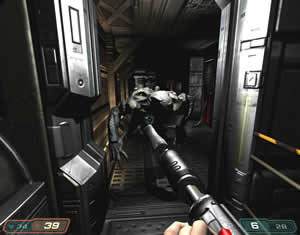
To measure performance on the game we used the timedemo demo1 command from the console (Alt+Ctrl+~).
Enabling the high quality setting and executing the timedemo demo1 command twice for each resolution, we witnessed the following:
First, without the Anti-Aliasing and Anisotropic Filtering settings
enabled, we got the following results:
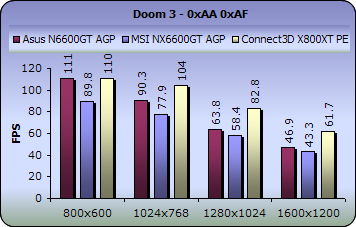
The Asus N6600GT has what it takes to render Doom3's demanding
scenes and this fact was widely publicized by NVidia when it introduced
the model
onto the market. With the framerate being around 60fps at 1280x1024
resolution, the Asus N6600GT is an excellent choice if you're a Doom fan.
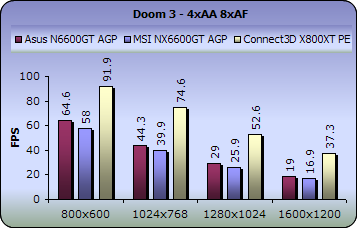
When we set AA to 4x and AF to 8x, the X800's much larger fill
rate comes into play. Comparing the two graphs above, you'll notice that
the card's performance only drops by 16% to 40% while the two 6600GTs
drop
by
40% to 60%.
11. Far Cry

 You are Jack Carver running your own boat charter business in beautiful Micronesia. With a past best left behind you, you'll be focusing on your present assignment: escorting an ambitious journalist named Valerie Cortez to the Island of Cabatu. It seems like a piece of cake, but you'll soon learn: paradise can be hell.
You are Jack Carver running your own boat charter business in beautiful Micronesia. With a past best left behind you, you'll be focusing on your present assignment: escorting an ambitious journalist named Valerie Cortez to the Island of Cabatu. It seems like a piece of cake, but you'll soon learn: paradise can be hell.
Farcry is an awesome First Person Shooter (FPS) based on a last generation 3D engine named as CryEngine. Real-time editing, bump-mapping, static lights, network system, integrated physics system, shaders, shadows and a dynamic music system are just some of the state of-the-art features that the CryEngine offers.
A great advantage and strong point of the CryEngine is its physics system which supports character inverse kinematics, vehicles, rigid bodies, liquid, rag doll, cloth and body effects. All physics seem to be very realistic and you never get bored when facing enemies, since character models have multiple animations that blend in believable ways.
With an integrated shader system and a massive terrain which maximizes
the view distance to 2km, these features make Farcry a perfect action game and
also a referable benchmark to speak of.
- Benchmark Settings
For this game we recorded a custom demo from the start of the Rebellion
stage. We chose an indoor scene in order to avoid getting the CPU bound effect. This will result in slightly higher results since it is also less
GPU intensive, but we can't afford being stuck at 40-50 fps because of our CPU.

The latest patch (1.3) was used for our tests which updates the
game's graphics engine to use the 3.0 Shader model. This option is only supported
for the 6800 series.

The resolutions we ran the demo at are as follows: 800x600,1024x768,
1280x1024 and 1600x1200. The first test was committed with Anti Aliasing (AA)
and Anisotropic Filtering (AF) features off. In the second test we leveled
up AA to 4x and AF to 8x. All tests were taken with Jack's flashlight on,
to increase
the game's demands from the graphics cards and with ai_update_interval set
to zero so that the results are subjective.
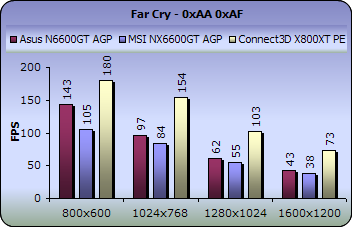
Even though Far Cry is known for its higher framerates on ATi
cards, the two 6600GTs are still performing fine. Under 1280x1024 we got
an average of 62fps which is probably the most suitable resolution at which
to enjoy the game.

Anti-Aliasing and Anisotropic Filtering is still an option but
only up to 1024x768. From that resolution and up, don't expect your
framerates to stay above 25fps at all times.
12. Thief 3
 Thief
3 Deadly Shadows is based on the same engine as DeusX. The
game makes severe use of Pixel Shader 1.1 instructions, the bloom effect
and stencil shadows to
Thief
3 Deadly Shadows is based on the same engine as DeusX. The
game makes severe use of Pixel Shader 1.1 instructions, the bloom effect
and stencil shadows to  achieve a wonderful result on your screen.
achieve a wonderful result on your screen.
In the game, you play the part of Master Thief Garrett who is back to
rule out any evil forces using his unique stealth abilities. Deadly Shadows
shows what stealth gameplay is all about. This game really gives you the
feeling of sneaking around and holding your breath when stuck in a sticky
situation.
Since there is no official benchmark for the game, we'll do our
tests using a GPU intensive scene from the tutorial-level which we believe
that represents the average fps you'll get when playing the game.

In Thief 3, the MSI NX6600GT managed to rank above the Asus N6600GT
for once. The difference however is small and the two 6600GTs show similar
performance. However, "the way it's meant to be played"
is shown by the X800XT PE with 41fps at 1280x1024.
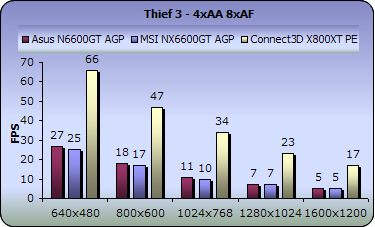
Starting with 27 and 25 fps at 640x480, the two 6600GT cards just show their lack of power to render the Multisampling and Anisotropic-Fitering enabled scene.
13. Colin McRae 05
 For all you racing fans out there, this test is for you and will represent the Racing game category in our benchmarks.
For all you racing fans out there, this test is for you and will represent the Racing game category in our benchmarks.
From the graphics point of view the first thing you'll
notice in the game is the excellent amount detail of your racing car. High
resolution textures on the car and lighting make it quite impressive. All
the eye candy such as the sun reflection in the virtual camera are still
the same as the older CM versions but motion blur has been added when your
card hits something hard which will happen most often if you're new to
the racing simulation world.
To measure performance on the game we used fraps to get the average fps of the whole 8th stage of UK which is actually the only stage you get to play on the demo.
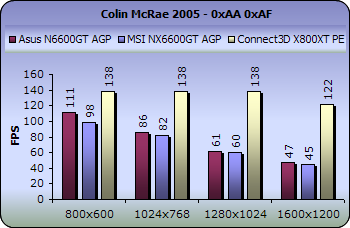
The Asus N6600GT performed well in this game. It started
with 111 fps at 800x600 and slowly decreases until it reached 47fps for
the highest resolution of 1600x1200.

As we enable 4x for AA and 8x for AF, gameplay remains enjoyable
but only up to 1280x1024 with an average of 36fps.
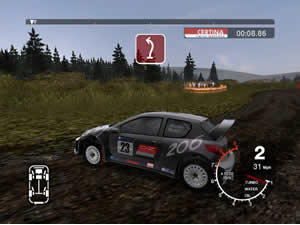
14. Ground Control II
 Ground
Control 2 is an action-oriented game of tactics and warfare. As Captain Jacob
Angelus of the Northern Star Alliance, you will command squads of infantry,
artillery, and airpower against the might of the Empire of Terra. Base building
and resource-collecting
are replaced with unit control and combat tactics where your knowledge of
the battlefield maneuvers will make the difference in your fight against
a ruthless enemy. Position your troops on hilltops for better aim or inside
buildings and forests for protection as you'll need to use every inch of
terrain to your advantage. Call in air strikes or assault pods to bring the
battle
behind enemy lines. Send out scouts to locate the enemy and use spotters
for your artillery with the 360° free-roaming camera. Experience the total
immersion of futuristic warfare as you lead your forces to victory!
Ground
Control 2 is an action-oriented game of tactics and warfare. As Captain Jacob
Angelus of the Northern Star Alliance, you will command squads of infantry,
artillery, and airpower against the might of the Empire of Terra. Base building
and resource-collecting
are replaced with unit control and combat tactics where your knowledge of
the battlefield maneuvers will make the difference in your fight against
a ruthless enemy. Position your troops on hilltops for better aim or inside
buildings and forests for protection as you'll need to use every inch of
terrain to your advantage. Call in air strikes or assault pods to bring the
battle
behind enemy lines. Send out scouts to locate the enemy and use spotters
for your artillery with the 360° free-roaming camera. Experience the total
immersion of futuristic warfare as you lead your forces to victory!
For our benchmarks, we used the highest possible settings on the first mission
of the single player game and moved around the camera to get an average framerate
using fraps.
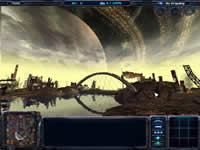
Ground Control II offers really impressive graphics without requiring much GPU power. Click on the picture above to view a screenshot from the game. Check out these excellent water effects!
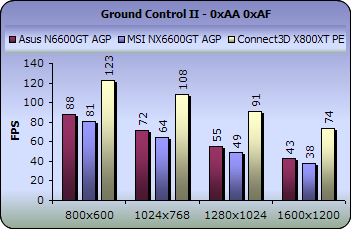
Ground Control II is plays excellently with the Asus
N6600GT. Even at the highest resolution the framerate remains above
40fps.
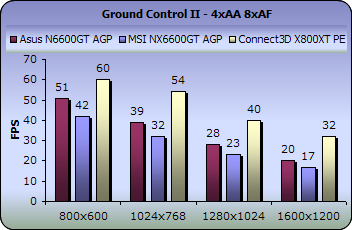
If you decide to enable Anti-Aliasing and Anisotropic-Filtering
to adjust the image quality of the game, you'd have to compromise with the
performance drop that it would bring. Even so, the Asus N6600GT did well
up to 1024x768.

15. Overclocking
No matter your graphics card, there comes a time in your computer's life when it can no longer cope with the latest technology the ever so popular games use. This is one of the main reasons for overclocking your graphics card. Gamers are always looking forward for a little extra boost in terms of framerate. Even though most of the times the boost is far from noticeable, overclocking remains the last resort when you can't afford to buy a brand new VGA card.
 |
Increasing the memory clock too much,
produces the so-called "artifacts". |
As we explained earlier, the Asus N6600GT comes stock clocked higher
than other vendor implementations of the 6600GT. It's core runs at 520MHz
and the memory at 550MHz.
Unlike other 6600GTs, the memory chosen by Asus is the 1.6ns K4J55323QF-GC16
by Samsung. This means that the theoretical maximum for the memory parts
is 625MHz.
Encouraged by that fact, we immediately set the memory clock to 600MHz. That
would create an effective memory fetch frequency of 1.2GHz which would boost
memory bandwidth even more. The card could run 3DMark05 and games
without producing artifacts so we set the clock to 605MHz. Once more, we
got no artifacts,
but that was the highest frequency where this was possible.
It was time to play around with the GPU clock speeds. Being used to other 6600GT versions we were hoping to push the clock from 520MHz to 550MHz. Unfortunately this wasn't possible and any option above 530MHz would at some point create artifacts or other screen anomalies and finally the system would freeze.
Here are some benchmark results, with the maximum stable overclocking settings on the Asus N6600GT :
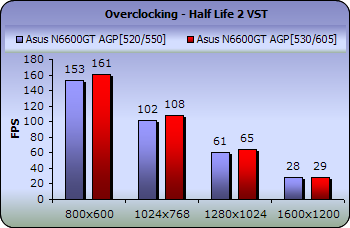
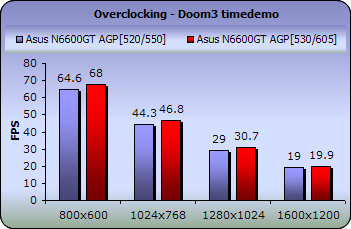
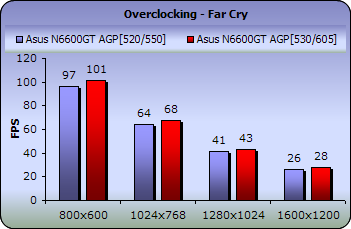
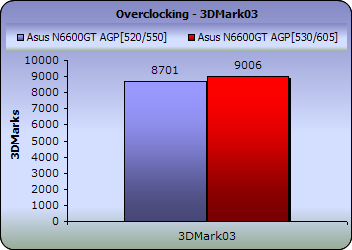
The boost in performance is much less than we originally expected
as the GPU clock could not be overclocked as high as we had hoped or
seen on similar graphics cards. As a result, we got a boost of 300 3DMarks
in 3DMark03 and
an average of 2 to 3 fps in the rest of the games.
16. Conclusion
The Asus N6600GT excelled in performance against the MSI NX6600GT. Its clocks are set higher than any other AGP oriented 6600GTs we've seen so far, delivering by far the highest stock-clocked performance.
The price of the Asus N6600GT AGP is approximately US$230. The
6600GT chipset on its own is an excellent buy and has been considered by
world-wide gamers as the perfect upgrade for mid-range computers. More so,
with the guaranteed
higher performance from Asus, the N6600GT stands out from the 6600GT crowd.
However, note that this TOP performance doesn't come for free. As always,
the Asus
implementation is a little pricier than those from other vendors.

Overclocking is not as effective as with other 6600GT since
the N6600GT has already been overclocked by Asus. The great memory components
permit an increase in
memory clock but unfortunately the GPU clock is not as accommodating.
Bundled along with the card, you'll find the full CD versions of Joint Operations : Typhoon rising and Xpand Rally. The first game is an online FPS you'll either love or hate due to its difficulty, while Xpand Rally is just a simple arcade/simulator rally hybrid. If you're a fan of either of these genres, the card's bundle will satisfy but probably won't excite you.

Pros:
- Already overclocked by Asus
- Great price/performance ratio
Cons:
- A little pricier than other 6600GT solutions
Performance: |
|
Value for money: |
|
Overclocking: |
|
Bundle: |
|